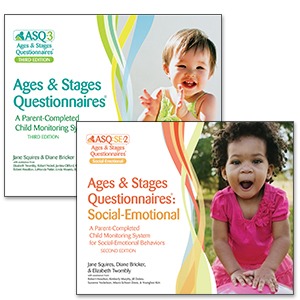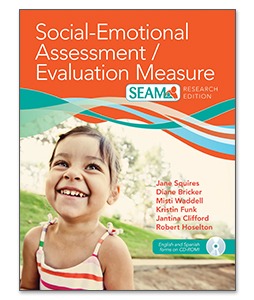How ASQ Can Help Support Healthy Development During COVID Recovery

There are few aspects of daily life that haven’t experienced upheaval during the ongoing pandemic, but disruptions in young children’s developmental progress could have the most significant long-term impact. Eighteen months of reduced social interactions, increased family stress, and prolonged absences from early learning environments mean that an increasing number of young children may be at risk for not reaching age-appropriate milestones. As your program continues to navigate its return to full-time in-person learning and/or service delivery, how can you be sure you’re doing all you can to help families support the healthy development of young children, both in the classroom and at home?
ASQ® can ease this challenging transition. This month, we’re highlighting tools and resources from the ASQ family of products that programs can use to meet the demands of the coming months, including catching up on developmental screening and monitoring, identifying potential delays as early as possible, assessing a young child’s home environment, and helping families support development between screenings.
Did you know that ASQ products are eligible to be purchased using Elementary and Secondary School Emergency Relief (ESSER) and Governor’s Emergency Education Relief (GEER) stimulus funds? We’re here to help you navigate your funding options. Get in touch today!
ASQ-3 and ASQ:SE-2
 Regular screening and early detection of social-emotional and developmental challenges are the key to helping young children reach their full potential. Trusted screeners like ASQ®-3 and ASQ®:SE-2 can give you the information you need to help get young children’s developmental progress back on track this fall. Screening now is especially important if your program wasn’t able to conduct virtual screenings during pandemic-related closures. Have families complete ASQ-3 and ASQ:SE-2 questionnaires for children at consistent intervals from birth to age 6, and you’ll have a quick and reliable check of their progress toward developmental and social-emotional milestones.
Regular screening and early detection of social-emotional and developmental challenges are the key to helping young children reach their full potential. Trusted screeners like ASQ®-3 and ASQ®:SE-2 can give you the information you need to help get young children’s developmental progress back on track this fall. Screening now is especially important if your program wasn’t able to conduct virtual screenings during pandemic-related closures. Have families complete ASQ-3 and ASQ:SE-2 questionnaires for children at consistent intervals from birth to age 6, and you’ll have a quick and reliable check of their progress toward developmental and social-emotional milestones.
Embedded in the ASQ screening process are many opportunities to expand parents’ knowledge of child development and increase their capacity to support their child’s progress after the screening is over. Sensitively discuss results with families after a screening, show them where their child’s skills are strongest, pinpoint areas where the child might need more support, carefully review follow-up actions like monitoring or assessment, and share appropriate resources to support the next stage of development. When you partner with the people who know the child best, you can make the most of screening and help ensure that the child meets their potential.
If you’ve just started using ASQ, or if you’re a current user in search of helpful resources, check out these screening success strategies. And if you’re still virtual for now, learn some tips for conducting effective online ASQ screenings.
ASQ-3 and ASQ:SE-2 Learning Activities
 As important as it is to screen young children regularly, it’s what happens at home between screenings that will have the most positive impact on children’s growth and bridge any developmental gaps that have opened up over the past 18 months. Young children spend the vast majority of their time with parents, caregivers, and other family members, so consistent family engagement and involvement will be key to supporting children’s development during the pandemic and beyond.
As important as it is to screen young children regularly, it’s what happens at home between screenings that will have the most positive impact on children’s growth and bridge any developmental gaps that have opened up over the past 18 months. Young children spend the vast majority of their time with parents, caregivers, and other family members, so consistent family engagement and involvement will be key to supporting children’s development during the pandemic and beyond.
Since healthy development starts (and is best supported) at home, make sure your program is using the ASQ-3 and ASQ:SE-2 Learning Activities (available in both English and Spanish). They’re an effective, affordable way to support parents and families in nurturing the development of children from birth to age 6 and boosting school readiness skills between screenings. Equally beneficial whether a child is developing typically or may be at risk for a delay, the fun, engaging learning activities will increase the daily number of close, enriching parent-child interactions and help families view everyday routines as valuable learning opportunities. And, parent newsletters outlining typical social-emotional development and practical handouts on key topics will support parents with concerns about sleep, anxiety, behavior, and more.
For an inside look at the learning activities for both ASQ-3 and ASQ:SE-2, download some free samples here.
SEAM™
 Developed by the ASQ author group as a natural extension of ASQ:SE-2, the Social-Emotional Assessment/Evaluation Measure (SEAM™) is a logical next step if a child’s ASQ:SE-2 score indicates a potential area of concern. SEAM is an in-depth discovery and planning tool that supports positive family outcomes by not only providing detailed information on a child’s social-emotional strengths and needs, but also reliably pinpointing areas where caregivers are doing well or may require additional support. SEAM is intended for use by programs that provide ongoing services to children and need guidance for developing functional intervention goals and improving social-emotional skills. Scenarios in which SEAM would be an ideal follow-up tool include:
Developed by the ASQ author group as a natural extension of ASQ:SE-2, the Social-Emotional Assessment/Evaluation Measure (SEAM™) is a logical next step if a child’s ASQ:SE-2 score indicates a potential area of concern. SEAM is an in-depth discovery and planning tool that supports positive family outcomes by not only providing detailed information on a child’s social-emotional strengths and needs, but also reliably pinpointing areas where caregivers are doing well or may require additional support. SEAM is intended for use by programs that provide ongoing services to children and need guidance for developing functional intervention goals and improving social-emotional skills. Scenarios in which SEAM would be an ideal follow-up tool include:
- As a preventive assessment to target improvement in particular areas if a child’s ASQ:SE-2 score is in the monitoring zone
- As a tool to develop intervention activities in situations where parents and/or providers don’t have access to evaluation and intervention resources in their community
- As a tool to develop intervention activities for children with developmental delays and disabilities whose ASQ:SE-2 scores have identified particular areas of concern
Building strong family partnerships is always important, but establishing open, healthy communication with families will be especially critical during the COVID-19 recovery. SEAM can support those goals by facilitating potentially delicate conversations, educating parents and caregivers about social-emotional milestones, and fostering high-quality parent-child interactions during the pivotal early years of development.
To learn more about SEAM, download a sample form here, watch this prerecorded webinar with two of the developers, and read this article on how to use ASQ:SE-2 and SEAM together.
Looking for a little expert guidance on addressing young children’s social-emotional needs during COVID-19? Check out this informative article featuring ASQ co-developer Jane Squires.
ESQ™
 Engaging families in ASQ screenings and activities will be essential to filling COVID-related gaps in children’s development, but many other family- and home-based factors can also have a profound influence on a child’s outcomes. Now you can quickly gather vital information about a child’s home environment with the Environmental Screening Questionnaire (ESQ™), a reliable (and free!) new screening tool created by ASQ co-developers Jane Squires and Diane Bricker.
Engaging families in ASQ screenings and activities will be essential to filling COVID-related gaps in children’s development, but many other family- and home-based factors can also have a profound influence on a child’s outcomes. Now you can quickly gather vital information about a child’s home environment with the Environmental Screening Questionnaire (ESQ™), a reliable (and free!) new screening tool created by ASQ co-developers Jane Squires and Diane Bricker.
The 30-item ESQ screener is meant to be completed in just 10 to 15 minutes by parents or caregivers of children ages birth to 6. It identifies possible risk factors in six key areas that could affect a family’s ability to support healthy child development: education and employment, housing, child and family health, economics and finances, family life, and community.
Used in conjunction with ASQ, the free ESQ screener will allow you to build a detailed picture of all the environmental influences on a child’s development, and target your services where families need them most. For more information, including a look at sample ESQ questionnaires in English and Spanish, click here.
Want a comprehensive overview of the ESQ? Check out the recorded version of this introductory ESQ webinar presented by Dr. Squires and Dr. Bricker. You’ll get tips and strategies for administering the ESQ either virtually or in-person, learn how ESQ results can be used to better support families, and more.
As we focus on COVID recovery efforts while managing the ongoing impact of the pandemic, young children and families will need a wide range of supports to ensure that developmental progress stays on track. Used together, the tools and activities in this article will help your program engage parents and caregivers, support children in developing critical skills, and monitor progress toward important milestones.


